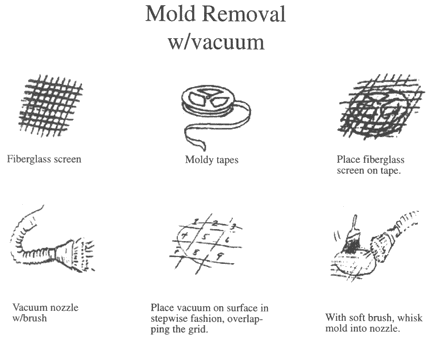
Volume 25, Number 4
Dec 2001
Recovery of Mold Damaged Magnetic Tape at
Vidipax: a Procedure Sheet

Mold can be an allergen, and in rare cases can be toxic to
humans. Please exercise extreme caution when handling moldy
materials. Always wear rubber gloves and a dust particulate mask
when handling materials with mold on them. After contact with mold,
always wash hands and face before eating or drinking.
Steps to recover mold damaged materials:
Upon receipt:
- Wearing a facemask and gloves, unpack the mold-damaged tapes,
and place on tables or shelves in a closed-off, ventilated room (a
triage room) that has low heat and humidity.
- If necessary, place a dehumidifier in the room with the
materials.
- If materials are wet, place a fan directed over the materials to
blow them dry.
Initial recovery:
- Wearing a facemask and gloves, remove a small group of tapes
(approximately ten) at a time to work on them in a clean room.
- One at a time, remove the tapes from the box. Use a post-it
note or other marker to mark the box and tape.
- If the box is cardboard, break the box down so that all sides
are flat. Photocopy the entire box. If the contract allows you to
do so, discard the box in a trash receptacle that will be emptied at
the end of the day. If the contract does not allow you to discard
the box, place it in a ziplock-type plastic bag. Place the
photocopy in a safe place to reunite with the moldy tape when it is
recovered.
- If the box is plastic, wipe it down with dilute isopropyl
alcohol in a ventilated area. Set aside to dry.
Vacuum recovery (illustrations):
- Wearing a facemask and gloves, set up the work area. Attach the
vacuum hose to the HEPA vacuum system. Also attach the soft brush
attachment.
- Set the tape on the work area and remove flanges from the tape,
if possible.
- Place fiberglass screen on top of tape.
- In a step-wise fashion place the vacuum brush nozzle on the
tape; work across the tape by setting the vacuum brush on the tape
and lifting it.
- If the mold is friable (easily damaged), use a very soft brush
and whisk the mold into the vacuum.
- Do not drag the vacuum nozzle over the tape; do not allow heavy
pressure on the edge of the tape.
- Repeat on the other side of the tape and set tape aside for
buffer-winder cleaning.
- Wipe down the work surface periodically with dilute isopropyl
alcohol (once every ten tapes). When work for the day has ended,
clean surfaces. Especially, clean the brush attachment and any
other brush that has been in contact with mold in a soapy solution,
and set out to dry overnight.
Buffer-winder cleaning:
- Wearing a facemask and gloves, place the tape on the appropriate
buffer-winder cleaning machine. NOTE: all workers in the vicinity
of the cleaning room must wear face masks when this cleaning occurs.
- Clean the tape as normal on the buffer-winder cleaning machine.
- Use the vacuum to aspirate mold particles from the pellon
material and from the vicinity of the cleaning machine during the
cleaning operation.
- Clean the cleaning machine with isopropyl alcohol when the batch
is through.
- Clean the photocopy machine.
Other notes:
- Take frequent breaks, as the mask can be fatiguing.
- Keep thorough notes about the amount of time spent on each tape
and about the condition of each tape.
- If necessary, we have a contract with a company that will
analyze mold (Pure Earth Environmental, 1-856-486-1177).
Dan Gaydos, who sent this information on request, made some
additional comments in his letter:
The procedures do not provide specifications on the face mask
and vacuum cleaner. The face mask is a nose/mouth apparatus which
accommodates 2 HEPA filter canisters that eliminate particulates
down to 1 micron or finer. An archivists' vacuum cleaner should
also accommodate a HEPA filter that blocks particulates of 1 micron
or finer. The ones we use are rated down to 0.3 microns.
When receiving mold-contaminated media from a client, we
routinely have the mold tested. It's a very quick, inexpensive
step, which assures the safety of both the client and the staff.
Some molds can be toxic, though almost all are irritating.
Buffer-winder cleaning is a proprietary process that is a
final cleaning after initial recovery and vacuum recovery. This
requires a high-speed transport across dust-free pellon rolls that
clean any mold from both sides of the actual tape surface, to
further ensure complete elimination of mold from the tape.
Resources:
- VidiPax, for complete magnetic media restoration service.
ph: 212-563-1999; http://www.vidipax.com/.
- Pure Earth Environmental Labs, for mold
testing.
ph: 856-486-1177; http://www.purearthlab.com/.
- Lab Safety Supply, for face masks, filters, vacuum cleaners.
ph: 800-356-2501; http://www.labsafety.com/.
- (VidiPax, the Magnetic Media Restoration Company, is at 450 West
31st St., 4th fl., New York, NY 10001; tel.
212/583-1999, fax 212/563-1994).
Reprinted from the Mold Reporter, Vol. 1, No. 6.
![[Contents]](../../img/contbtn.gif)
![[Search]](../../img/srchbtn.gif)
![[Abbey]](../../img/abbbtn.gif)


